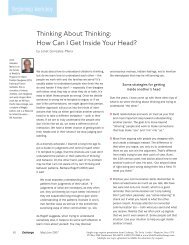rough and tumble play 101 - ChildCareExchange.com
rough and tumble play 101 - ChildCareExchange.com
rough and tumble play 101 - ChildCareExchange.com
Create successful ePaper yourself
Turn your PDF publications into a flip-book with our unique Google optimized e-Paper software.
ROUGH AND TUMBLE PLAY 71<br />
JULY/AUGUST 2009<br />
EXCHANGE<br />
children are learning the give-<strong>and</strong>-take<br />
of appropriate social interactions. Successful<br />
participation in this <strong>play</strong> requires<br />
children to be<strong>com</strong>e adept at both signaling<br />
<strong>and</strong> detecting signals — a social skill<br />
they will need <strong>and</strong> use th<strong>rough</strong>out their<br />
lives. When detecting these signals, they<br />
are learning to read <strong>and</strong> underst<strong>and</strong><br />
the body language signifying the <strong>play</strong><br />
should <strong>com</strong>e to an end. The <strong>play</strong> also requires<br />
children to alternate <strong>and</strong> change<br />
roles. Sometimes one child chases; at<br />
another time the child is chased. Because<br />
this give-<strong>and</strong>-take mimics successful<br />
social conversations <strong>and</strong> interactions,<br />
the social roles practiced <strong>and</strong> learned in<br />
<strong>rough</strong> <strong>and</strong> <strong>tumble</strong> <strong>play</strong> provide children<br />
with the social knowledge needed for<br />
future relationships.<br />
Physical benefits of <strong>rough</strong> <strong>and</strong><br />
<strong>tumble</strong> <strong>play</strong><br />
Social <strong>and</strong> emotional domains are not<br />
the only developmental areas positively<br />
affected by this <strong>play</strong>. When children use<br />
this big-body <strong>play</strong>, the intense physical<br />
exertion of <strong>rough</strong> <strong>and</strong> <strong>tumble</strong> <strong>play</strong> also<br />
supports cardiovascular health. Th<strong>rough</strong><br />
their involvement, young children get<br />
the moderate to vigorous physical activity<br />
needed for optimum physical health.<br />
And, because <strong>rough</strong> <strong>and</strong> <strong>tumble</strong> <strong>play</strong> is<br />
so physical, children get many of their<br />
vital touch needs met th<strong>rough</strong> the <strong>play</strong><br />
(Carlson, 2006). Because the preschool<br />
period is a critical period for children to<br />
develop both physically <strong>and</strong> emotionally,<br />
<strong>rough</strong> <strong>and</strong> <strong>tumble</strong> <strong>play</strong> for preschoolers<br />
is invaluable.<br />
Rough <strong>and</strong> <strong>tumble</strong> <strong>play</strong> vs.<br />
aggression<br />
What about the fears? Is <strong>rough</strong> <strong>and</strong> <strong>tumble</strong><br />
<strong>play</strong> the same as real fighting? Let’s<br />
look at three factors present in <strong>rough</strong><br />
<strong>and</strong> <strong>tumble</strong> <strong>play</strong> <strong>and</strong> <strong>com</strong>pare them to<br />
three factors present in real fighting:<br />
n In <strong>rough</strong> <strong>and</strong> <strong>tumble</strong> <strong>play</strong>, children’s<br />
expressions are often characterized<br />
by smiles; they are often laughing. In<br />
real fighting, children’s expressions<br />
are characterized by frowns as well as<br />
tears.<br />
n In <strong>rough</strong> <strong>and</strong> <strong>tumble</strong> <strong>play</strong>, the<br />
children involved are willing participants.<br />
They join the <strong>play</strong> readily <strong>and</strong><br />
eagerly <strong>and</strong> remain as long as the<br />
<strong>play</strong> sustains. In real fighting, one<br />
participant is usually dominating<br />
another one.<br />
n In <strong>rough</strong> <strong>and</strong> <strong>tumble</strong> <strong>play</strong>, the<br />
children keep returning for more. In<br />
real fighting, as soon as an episode<br />
resolves, the unwilling participants<br />
often flee.<br />
Even for parents <strong>and</strong> teachers who<br />
recognize the signs of <strong>rough</strong> <strong>and</strong> <strong>tumble</strong><br />
over <strong>play</strong> fighting, there often is a concern<br />
that — if allowed to continue — the<br />
<strong>play</strong> will be<strong>com</strong>e fighting. The reality,<br />
though, is that <strong>rough</strong> <strong>and</strong> <strong>tumble</strong> <strong>play</strong><br />
digresses into real fighting less than 1%<br />
of the time for preschoolers (Scott &<br />
Panksepp, 2003). Comforting to know,<br />
too, is that most<br />
children are quite adept at recognizing<br />
that the <strong>play</strong> is <strong>rough</strong> <strong>and</strong> <strong>tumble</strong><br />
<strong>and</strong> not real fighting, <strong>and</strong> they respond<br />
accordingly in order to sustain the <strong>play</strong>.<br />
Actually, children are better at discerning<br />
<strong>rough</strong> <strong>and</strong> <strong>tumble</strong> from real fighting<br />
than are their teachers (Boulton, 1996).<br />
Environments that support<br />
<strong>rough</strong> <strong>and</strong> <strong>tumble</strong> <strong>play</strong><br />
So how can parents <strong>and</strong> teachers ensure<br />
the <strong>play</strong> remains safe? Often, supervising<br />
adults fear a child may tag too hard,<br />
or tag on a vulnerable body part.<br />
What if a child is chasing <strong>and</strong><br />
trips <strong>and</strong> falls? What if children<br />
are wrestling <strong>and</strong> one or more<br />
of them gets pinched, strained,<br />
bruised, or worse? To support<br />
<strong>rough</strong> <strong>and</strong> <strong>tumble</strong> <strong>play</strong> <strong>and</strong><br />
maintain its appropriateness,<br />
parents <strong>and</strong> teachers need to<br />
first ensure the surrounding<br />
environment is as safe as possible.<br />
Look for <strong>and</strong> offer the<br />
PHOTOGRAPH BY THE AUTHOR<br />
following environmental features:<br />
n Are all hard edges rounded instead of<br />
pointed?<br />
n Are the rugs skid-free?<br />
n Is the area free of tripping hazards?<br />
n Is there enough space for the children<br />
to move around <strong>com</strong>fortably?<br />
n Is there an indoor or outdoor safety<br />
surface to absorb the shock of falling?<br />
n Are the walls <strong>and</strong>/or sides of surrounding<br />
equipment padded or<br />
covered with padding?<br />
Policies <strong>and</strong> rules for <strong>rough</strong> <strong>and</strong><br />
<strong>tumble</strong> <strong>play</strong><br />
Before planned or unplanned <strong>rough</strong> <strong>and</strong><br />
<strong>tumble</strong> <strong>play</strong> occurs, help the children<br />
develop rules or policies to guide the<br />
<strong>play</strong>. For example, when <strong>play</strong>ing ‘Duck,<br />
Duck, Goose,’ make sure children underst<strong>and</strong><br />
that all tags are with an open<br />
h<strong>and</strong> <strong>and</strong> can only be made on the arms<br />
<strong>and</strong> shoulders <strong>and</strong> not on the head. If<br />
your classroom has an area dedicated<br />
to big-body <strong>play</strong>, post a prominent sign<br />
with both pictures <strong>and</strong> words to remind<br />
children how to keep the <strong>play</strong> appropriate.<br />
The sign might list these rules:<br />
n No kicking<br />
n Tags with open h<strong>and</strong>s only<br />
n No choking<br />
n Keep h<strong>and</strong>s away from hair <strong>and</strong><br />
heads<br />
n Smiles stop — Play stops<br />
Supervising adults can help children<br />
develop body language or a body code<br />
that will allow them to better <strong>com</strong>municate<br />
with their <strong>play</strong>mates if the






